Menus
- A big shovel of coals added
- Neutrality is still not the strength
- Emotionally strong supermoto bikes
- Scoring / conclusion
- Ducati Hypermotard SP
- Technical specifications
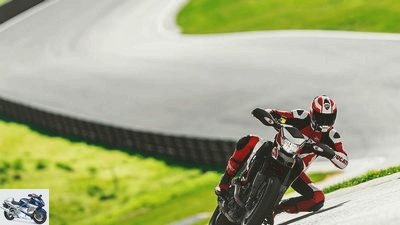
Manufacturer
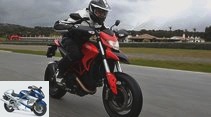
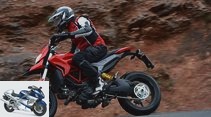
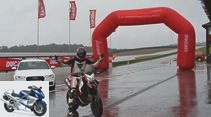
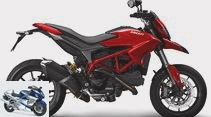
46 photos
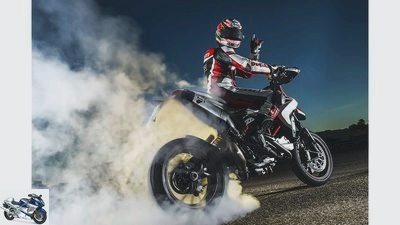
Ducati
1/46
Ducati Hypermotard 2013 in the driving report.
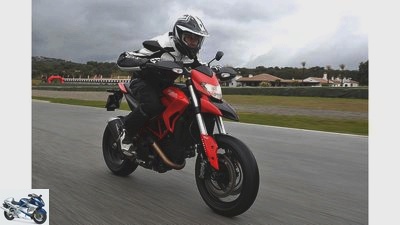
Ducati
2/46
Red, a bit simpler, but quite functional: the Hypermotard in the rain.

Ducati
3/46
Ducati Hypermotard 2013 in the driving report.
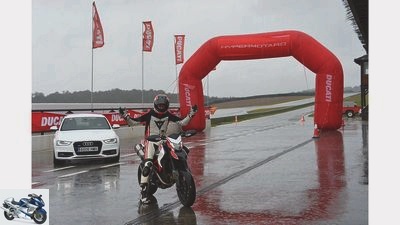
Ducati
4/46
Ducati Hypermotard 2013 in the driving report.
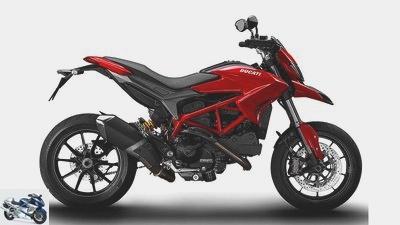
Ducati
5/46
The basic variant.
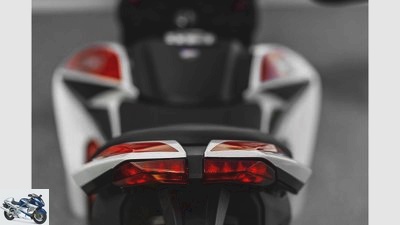
Ducati
6/46
Consistent: reduced rear frame with hidden handles next to the taillights.
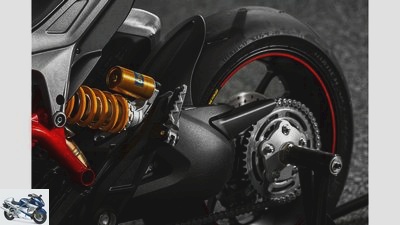
Ducati
7/46
Compact: The shock absorber is supported directly on the swing arm and frame.
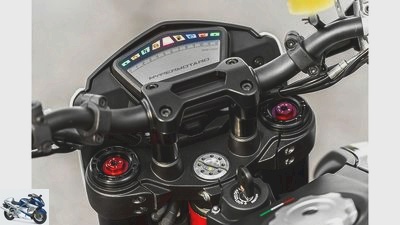
Ducati
8/46
Complete: From the outside temperature display to the driving mode, everything is there.

Ducati
9/46
Brand new, from Brembo and from a single source: the brake.
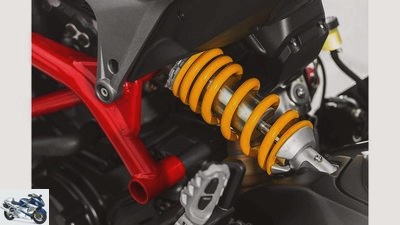
Ducati
10/46
From Sachs and without compression adjustment: the shock absorber.

Ducati
11/46
Ducati Hypermotard 2013 in the driving report.
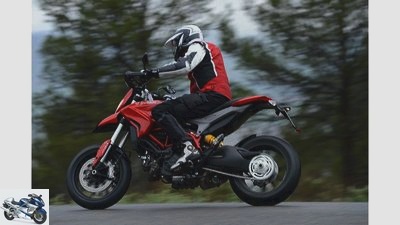
Ducati
12/46
Ducati Hypermotard 2013 in the driving report.

Ducati
13/46
Ducati Hypermotard 2013 in the driving report.
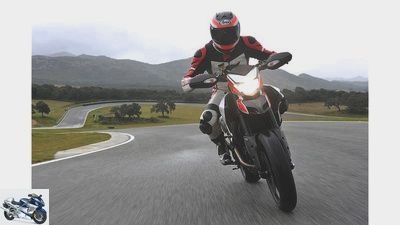
Ducati
14/46
Ducati Hypermotard 2013 in the driving report.
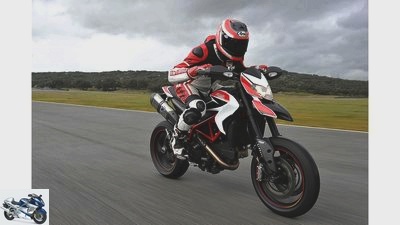
Ducati
15/46
Ducati Hypermotard 2013 in the driving report.
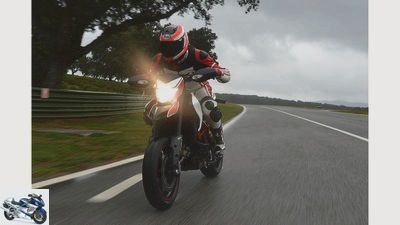
Ducati
16/46
Ducati Hypermotard 2013 in the driving report.
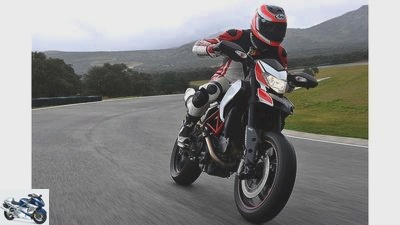
Ducati
17/46
Ducati Hypermotard 2013 in the driving report.
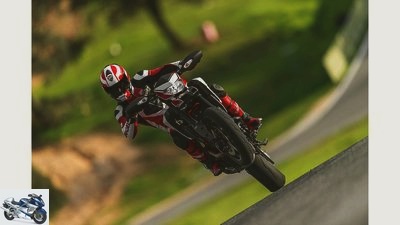
Ducati
18/46
Ducati Hypermotard 2013 in the driving report.

Ducati
19/46
Ducati Hypermotard 2013 in the driving report.

Ducati
20/46
Ducati Hypermotard 2013 in the driving report.
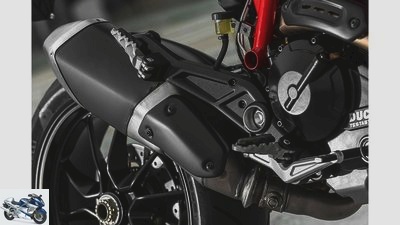
Ducati
21/46
The exhaust below largely determines the new look.
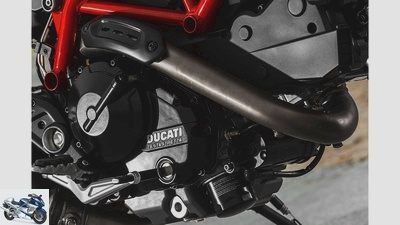
Ducati
22/46
Welcome: The new, water-cooled 821 cm³ engine gives the Hypermotard more power, more smoothness and ultimately more driving pleasure. The engineers housed the cooler in a relatively inconspicuous manner.
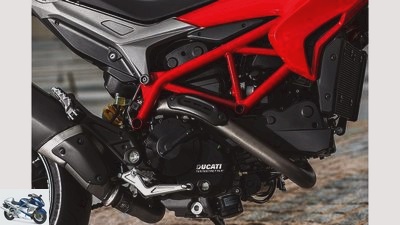
Ducati
23/46
Ducati Hypermotard 2013 in the driving report.
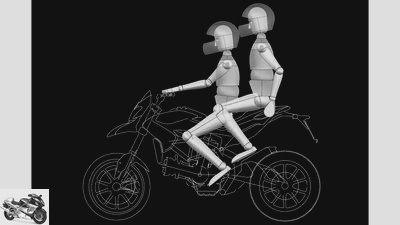
Ducati
24/46
Ducati Hypermotard 2013 in the driving report.
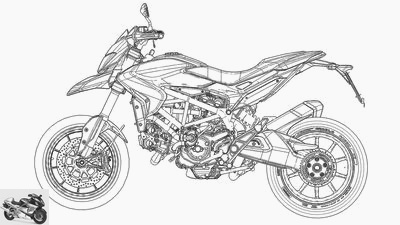
Ducati
25/46
Ducati Hypermotard 2013 in the driving report.

Ducati
26/46
Ducati Hypermotard 2013 in the driving report.
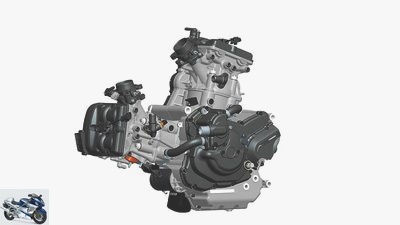
Ducati
27/46
Ducati Hypermotard 2013 in the driving report.
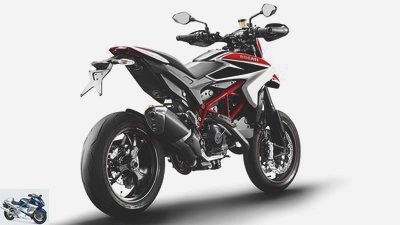
Ducati
28/46
Convincing: the Hypermotard from its chocolate side with single-sided swing arm, filigree forged wheels and this successful exhaust.
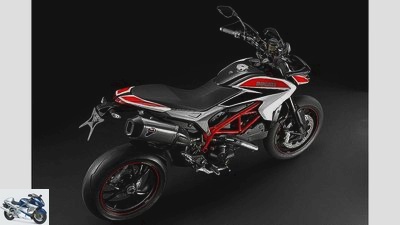
Ducati
29/46
Ducati Hypermotard 2013 in the driving report.
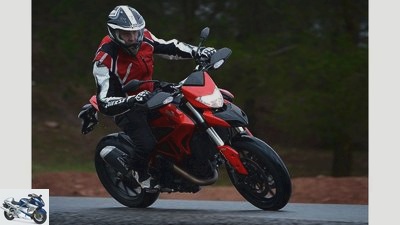
Ducati
30/46
Ducati Hypermotard 2013 in the driving report.
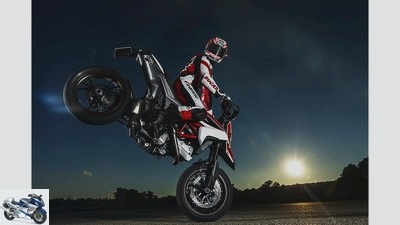
Ducati
31/46
Ducati Hypermotard 2013 in the driving report.
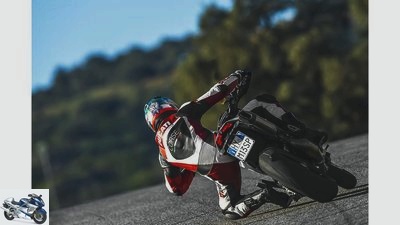
Ducati
32/46
Ducati Hypermotard 2013 in the driving report.
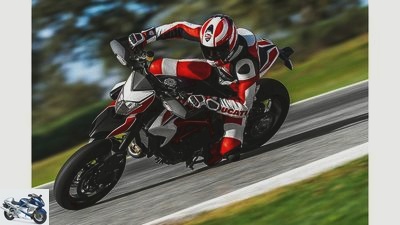
Ducati
33/46
Ducati Hypermotard 2013 in the driving report.

Ducati
34/46
Ducati Hypermotard 2013 in the driving report.
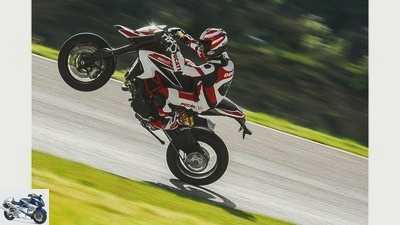
Ducati
35/46
Ducati Hypermotard 2013 in the driving report.
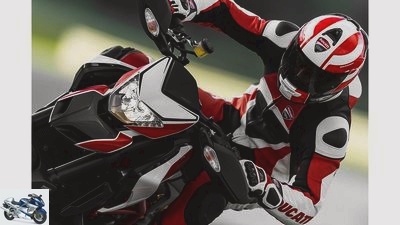
Ducati
36/46
Ducati Hypermotard 2013 in the driving report.

37/46
Footrests: As with the Multistrada, the rubber pads of the footrests are only inserted. For off-road use, the inserts can be pushed out so that the serrated profile gives the boots a better grip – even if the off-road ambitions of the Hypermotard clientele are rather restrained.
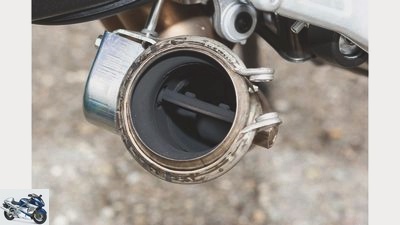
38/46
Exhaust flap: Like most current motorcycles, the Hypermotard also uses an exhaust flap in order to comply with the noise limits. It is controlled by an electric servomotor via a cable pull.
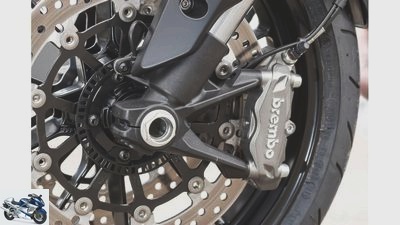
39/46
The standard ABS works first class.
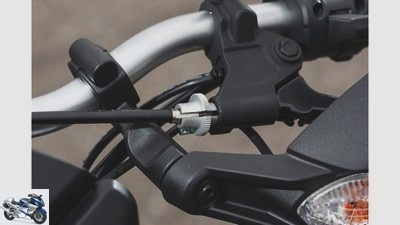
40/46
The clutch is now operated by a cable instead of hydraulically.
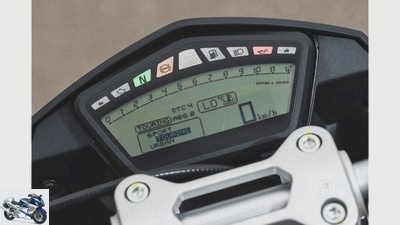
41/46
There are three driving modes to choose from.

42/46
As before, the turn signals are integrated into the handcases, only the unorthodox folding mirrors had to give way to traditional variants.
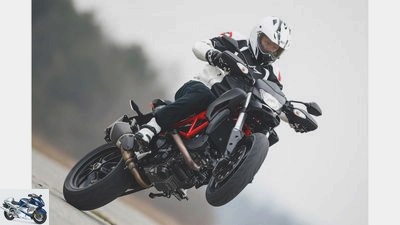
43/46
The new Ducati Hypermotard. New water-cooled engine, revised chassis and standard ABS.
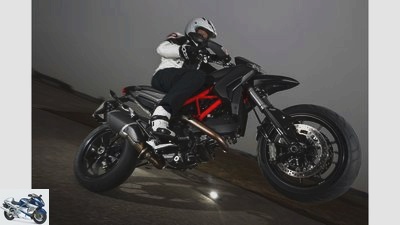
44/46
Ducati Hypermotard 2013 in the driving report.

45/46
Luggage: Since luggage hooks do not match the Supermoto look, four straps screwed to the seat offer the opportunity to lash luggage.

46/46
Tire valve: Cranked valves make it easier to check the air pressure on the front wheel. Because of the single-sided swing arm, the off-center, straight valve on the rear wheel of the Hypermotard is sufficient for the air pressure check.
Ducati Hypermotard in the top test:
A big shovel of coals added
The Ducati Hypermotard has undergone a general overhaul. With a water-cooled 821 cm³ engine, completely redesigned chassis and standard ABS, the Supermoto bike should stay ahead and stay ahead.
The photo went around the world: Ruben Xaus bends with the D.ucati Hypermotard 1100 in a daring drift into a left turn. The knee is dragging on the floor, while the superbike star casually stretches his left hand upwards. Ducati couldn’t have staged its interpretation of the supermoto theme in a more spectacular way. But as fresh as the impression of this furious debut may still be in the mind, the weird number is now six years ago. Obviously long enough for the Bolognese to polish up the contemporary runabout. Or more correctly: to design from scratch.
Buy complete article
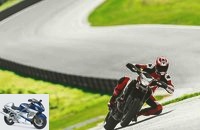
Ducati Hypermotard in the top test:
A big shovel of coals added
Water-cooled 821 cm³ Testastretta four-valve engine
Because with the previous Ducati Hypermotard, the new one hardly has a screw in common. The air-cooled two-valve engine? Replaced by a water-cooled 821 cm³ Testastretta four-valve engine. The overhead silencers? Transformed into a trendy, side-mounted exhaust. The shock absorber activated by push rods? Articulated directly on the swing arm. The tubular frame rear? Replaced by a delicate cast aluminum part. And all of this is garnished with ride-by-wire electronics (three driving modes, traction control), modified chassis geometry (50 millimeters longer wheelbase, 1.5 degrees flatter steering angle) and ABS as standard. Uff.
It’s amazing how much the Ducati Hypermotard has remained true to its appearance despite this new design. Filigree, slim, no part too many. Hypermotard fans should also have a portion of sportiness. At 885 millimeters, the fun bike surpasses all current travel enduros in seat height. Ducati offers a 20 millimeter lower seat (240 euros) in the accessories catalog. The first ascent immediately arouses familiar feelings. The Duc moves the pilot far towards the handlebars. Bad omen? After all, the front-heavy chassis design with the resulting wobbly steering behavior represented the dynamic Achilles heel of the previous Hypermotard models. Let’s wait and see.
Because at first the engine of the new Ducati Hypermotard thuds so loudly from the silencer below, as if the electronically controlled exhaust flap had already been turned on with idle. Release the clutch, which is easy to pull – and which has recently been operated via a cable instead of a hydraulic line – and it pounds again right into the handlebars, the typical, gently massaging heart of the 90-degree Vauzwo. It is impressive how easily the Desmo four-valve engine shakes itself out of the somewhat untidy engine speed range under 3000 rpm and then pushes it through the engine speed range with easily calculable linear pressure. Memories of the engine of the Multistrada are immediately awakened. And not by chance. In addition to the clever choice of flywheel mass, the 821 L-Twin obviously benefits from the valve overlap of eleven degrees, which has already proven itself in the engine of the large travel enduro. Better still: the displacement disadvantage compared to the 1198 cc Multistrada engine is what the Junior Testastretta converts into fine running smoothness and lively revving. Involuntarily, the driver of the Ducati Hypermotard uses a much wider speed range than its thick counterpart and only then notices that the new propellant with measured 107 hp adds a big shovel of coal compared to the previous Hypermotards.
Neutrality is still not the strength
There is a huge 32 PS difference to the 796 and still 12 PS to the 1100 Evo. The easy-going character of the 821 unit also influences the choice of driving modes. Even the direct throttle response in sport mode is fun and does not overwhelm anyone, those who are less in a hurry can choose the marginally softer bite of the touring mapping. Both votes were successful. However, the urban set-up makes less sense. The slow response robs the Duc engine of its spontaneity; the engine, which is already easy to control, does not need the peak power reduced to 87 hp. In this user-friendly environment, even the traction control, which can be individually adjusted in eight stages, takes a back seat. The different intensity of the intervention in the various settings can be clearly felt, but common sense should never replace the slip control.
The new Ducati Hypermotard. New water-cooled engine, revised chassis and standard ABS.
Like now. Ui, too fast again? Occurs more often with Supermoto machines. Especially with the Ducati. Elbows up, upper body and head forward – the Hypermotard still places its rider aggressively front-facing even after the chassis geometry has been revised. Is it that? Because the fact is: neutrality is still not Ducati’s strength. Especially in tight bends, the front wheel tilts towards the inside of the bend and has to be brought on course with counter pressure on the handlebars. The more bumpy the surface, the more. A feeling of security will only arise when the Ducati Hypermotard is kept on tension and the front wheel is relieved. Brake early and accelerate as soon as you enter the corner, that is the recipe for a clean line on the Italian.
And a tire change. Experimentally assembled, good-natured Conti Road Attack 2 (series: Pirelli Diablo Rosso II) virtually transform the Hypermotard. Said tendency to collapse in curves is blown away, the steering precision gains enormously. A very hot tip – through which the Ducati Hypermotard can show off its second strength: its handling. It’s great how effortlessly the fun mobile can be thrown in alternating curves from one to the next inclined position, with a slim waist and narrow knee giving a feeling of lightness. It is hardly noticeable that the optically so airy Ducati Hypermotard has put on seven kilos compared to its predecessor. It is more likely that the seat hollow is a bit tight for drivers over 1.80 meters. Just five centimeters more space to the rear would relax the sitting posture and – perhaps – help to take the said load off the front of the vehicle. In spite of everything: The New Worlds separate from the front-heaviness of previous Hypermotard models.
The suspension of the Ducati Hypermotard also demands the chassis. If the non-adjustable 43 mm front fork from Kayaba is well tuned and only passes rough blows to the driver, the Sachs shock absorber gives the tough sportsman. Even when the rebound is fully cranked, the rear end bounces insensitively over the country road, reducing comfort and causing additional unrest in the chassis in undulating corners.
Emotionally strong supermoto bikes
The standard ABS works first class.
The sunny side of this set-up: the fun bike does not know pumps at the rear, even under full acceleration in an inclined position. And it is just as easy on the nerves as the ABS, which is now standard. There are two levels available that can be individually assigned to the driving modes via the setup menu. And as with the recently so successfully revised Multistrada, the system also does a great job in the new Ducati Hypermotard. With fine control processes and little manual force required, the Bosch (modulator) and Brembo (brake calipers, fittings) combo decelerates the Ducati efficiently and calmly even in moderate level 2. The sporty level 1 should make little sense in an emergency due to the critical tendency to stop outside of the racetrack. Especially since it only shortens the braking distance marginally (by 40 centimeters).
The reserve lamp lights up. 16 liters (previously 12.4 liters) is now held by the tank, which extends well under the seat. This is not only enough for the Sunday round, but also for the day trip in the Alps, even if the modern engine technology does not have a positive effect on fuel consumption on the Ducati Hypermotard. With 5.1 liters (country road) and 5.7 liters (motorway), the 821 consumes up to half a liter more than its economical predecessors.
So be it. Because not least thanks to the new, brilliant engine, the Ducati Hypermotard fulfills its role even better: that of an emotionally strong supermoto bike. Señor Xaus already demonstrated it back then.
Scoring / conclusion
Ducati Hypermotard 2013 in the driving report.
engine
The performance of the new Ducati Hypermotard was significantly better in all areas than that of its air-cooled predecessors. Above all, the easily controllable power development and the very smooth running for a two-cylinder make the V2 engine not only suitable for sporty use, but also for everyday use. The anti-hopping clutch effectively prevents the rear wheel from jarring when downshifting quickly and is also pleasing with moderate manual force. The gearshift also works smoothly.
landing gear
(Supermoto) racetracks probably influenced the suspension setup. The front wheel orientation is much less than with the previous Ducati Hypermotard models, but the nervous cornering and steering behavior is the price for the pronounced handiness. The Duc also pays homage to this alignment with a relatively unstable straight-line stability – at least on bumpy slopes. A criterion to which the firm suspension also plays its part. Surprising: The weight of the passenger brings the Duc’s top-heavy balance into balance and hardly has a negative effect on the handling.
everyday life
The sitting position, which is very close to the handlebars, still characterizes the ergonomics of the Ducati Hypermotard, which takes a bit of getting used to. Nobody expects effective wind protection from a supermoto bike. The conventional rear-view mirrors are less original than the folding counterparts of their predecessors, but they offer a much better view to the rear. Also better: the new, brighter headlight. With the tank enlarged from 12.4 to 16 liters, the range has also increased to a practical value of 314 km. The workmanship is valuable.
security
The classy monoblock calipers from Brembo put themselves in the limelight with efficient deceleration and easy control. The ABS is very well coordinated. However, on bumpy stretches the front gets restless. A steering damper on the Ducati Hypermotard would certainly be a good investment. The relatively long suspension travel ensures sufficient ground clearance.
costs
The fuel consumption is still within acceptable limits. The long service intervals of 15,000 kilometers earn points. Also good: valve clearance checks are only performed every 30,000 kilometers.
Price-performance
Is a Hypermotard expensive at 11,500 euros? The excellent price-performance rating proves the opposite. The Ducati Hypermotard offers something for the money.
| Max. score | Ducati Hypermotard | Overall rating | 1000 | 663 |
| Price-performance note | 1.0 | 1.8 |
Conclusion
The new new Ducati Hypermotard is superior to its predecessor in every respect. The 821 engine combines character, smoothness and universality, the look is even more pleasing, the ABS controls first-class and the driving behavior is much more neutral. The latter, however, remains relative. Your steering behavior is – at least with the series tires – still nervous, the suspension could be more comfortable.
Ducati Hypermotard SP
Ducati
Convincing: the Hypermotard from its chocolate side with single-sided swing arm, filigree forged wheels and this successful exhaust.
As usual with many Ducati models, the Italians also offer an upgraded version of the Hypermotard, the Ducati Hypermotard SP. For the noble version, however, a hefty financial add-on is due with 3400 euros. It differs from the basic version in the following points:
- Forged rims from Marchesini (basic version: cast rims)
- Upside-down fork from Marzocchi with carbon-coated sliding tubes (basic version: Kayaba)
- Ohlins shock absorber with extensive adjustment options (basic version: Sachs, only adjustable spring base and rebound damping)
- Spring travel extended to 175/185 mm (front / rear) (basic version: 170/150 mm)
- Pirelli Supercorsa SP tires (basic version: Pirelli Diablo Rosso II)
- Front fender and timing belt cover made of carbon (basic version: plastic)
- Multi-color painting (basic version: single-color painting)
- Price 14,590 euros (basic version: 11 190 euros)
Exhaust flap to comply with noise limits.
Exhaust flap
Like most current motorcycles, the Hypermotard also uses an exhaust flap to comply with noise limits. It is controlled by an electric servomotor via a cable pull.
As with the Multistrada, the rubber pads on the footrests are only plugged in.
Footpegs
As with the Multistrada, the rubber pads on the footrests are only inserted. For off-road use, the inserts can be pushed out so that the serrated profile gives the boots a better grip – even if the off-road ambitions of the Hypermotard clientele are rather restrained.
Four straps screwed to the seat for luggage.
Luggage
Since luggage hooks do not match the Supermoto look, four straps screwed to the seat offer the opportunity to lash the luggage.
Cranked valves make it easier to control the air pressure on the front wheel.
Tire valve
Cranked valves make it easier to control the air pressure on the front wheel. Because of the single-sided swing arm, the off-center, straight valve on the rear wheel of the Hypermotard is sufficient for the air pressure check.
Technical specifications
Ducati
Red, a bit simpler, but quite functional: the Hypermotard in the rain.
engine
Water-cooled two-cylinder four-stroke 90-degree V-engine, two overhead, toothed belt-driven camshafts, four valves per cylinder, desmodromic, wet sump lubrication, injection, Ø 52 mm, regulated catalytic converter, alternator, 12 V battery, mechanically operated multi-disc oil bath clutch (Anti-hopping), six-speed gearbox, O-ring chain, secondary ratio 45:15.
Bore x stroke 88.0 x 67.5 mm
Displacement 821 cm³
Compression ratio 12.8: 1
rated capacity 81.0 kW (110 hp) at 9250 rpm
Max. Torque 89 Nm at 7750 rpm
landing gear
Steel tubular frame, load-bearing motor, upside-down fork, Ø 43 mm, single-sided swing arm made of aluminum, spring strut, directly hinged, adjustable spring base, rebound damping, double disc brake at the front, Ø 320 mm, four-piston fixed calipers, disc brake at the rear, Ø 245 mm, two-piston -Fixed caliper, ABS, traction control.
Cast aluminum wheels 3.50 x 17; 5.50 x 17
Tires 120/70 ZR 17; 180/55 ZR 17
Tires in the test Pirelli Diablo Rosso II, front “D”
Dimensions + weight
Wheelbase 1500 mm, steering head angle 64.5 degrees, caster 104 mm, suspension travel f / h 170/150 mm, permissible total weight 406 kg, tank capacity 16.0 liters.
Service data
Service intervals 15,000 km
Oil and filter change every 15,000 km / 3.5 l
Engine oil SAE 15 W 50
Telescopic fork oil SAE 7.5
Spark plugs NGK MAR9A-J
Tire pressure solo (with pillion passenger) front / rear 2.5 / 2.5 (2.5 / 2.9) bar
Two year guarantee
Mobility guarantee two years
Colors red, black
Price 11,190 euros
Price test motorcycle 11,190 euros
Additional costs around 305 euros
Related articles
-
Single test: Ducati Hypermotard
Manufacturer 37 pictures Ducati 1/37 Ducati Hypermotard 2013 in the driving report. Ducati 2/37 Ducati Hypermotard 2013 in the driving report. Ducati 3/37 red, a little …
-
Comparison test KTM 990 Supermoto versus Ducati Hypermotard 1100
Mayer comparison test KTM 990 Supermoto versus Ducati Hypermotard 1100 Supermoto duel Crass edges or curved lines: With the Hypermotard 1100 …
-
MV Agusta Rivale, Ducati Hypermotard SP and Husqvarna Nuda 900 R in the test
www. 46 pictures www. 1/46 The Husqvarna Nuda 900 R landed in second place. MV Agusta Rivale came in last …
-
Ducati Monster 1200 S in the top test
www. 33 Pictures 1/33 2/33 Noticeable negative: When folding up the tank gets stuck at the front, so the …
-
Comparison test: Ducati Hypermotard 796 against Aprilia Dorsoduro
Bilski Ducati Hypermotard 796 versus Aprilia Dorsoduro Italian mid-range supermotos Singles are too rough, two-cylinder supermotos too expensive? Quite…
-
Top test Ducati Hypermotard 1100 S
Artist Top test Ducati Hypermotard 1100 S Bella Figura Whether randale grande or dolce vita. Everyone cuts a fine figure with the Ducati Hypermotard. But…
-
KTM 990 Supermoto R, Ducati Hypermotard and Husqvarna Nuda 900 R ABS in the test
fact 31 photos fact 1/31 Husqvarna Nuda 900 R ABS, Ducati Hypermotard and KTM 990 SM R in a comparison test. fact 2/31 Husqvarna Nuda 900 R ABS. fact…
-
KTM 690 SMC-R and Ducati Hypermotard 950 SP in a comparison test
15th photos to the video fact / Joachim Schahl 1/15 Trends come and go. In any case, supermotos are coming, and with power. fact / Joachim Schahl 2/15…
-
Ducati Hyperstrada in the test
Bilski 20 pictures Bilski 1/20 Ducati Hyperstrada in the MOTORRAD compact test. Bilski 2/20 Ducati Hyperstrada in the MOTORRAD compact test. Bilski 3/20 Ducati …
-
Ducati Hypermotard 939, Yamaha MT-09 and Aprilia Dorsoduro 900 in comparison test
Arturo Rivas Ducati Hypermotard 939, Yamaha MT-09 and Aprilia Dorsoduro 900 Funbikes in comparison test Seriously: fun and common sense are often…